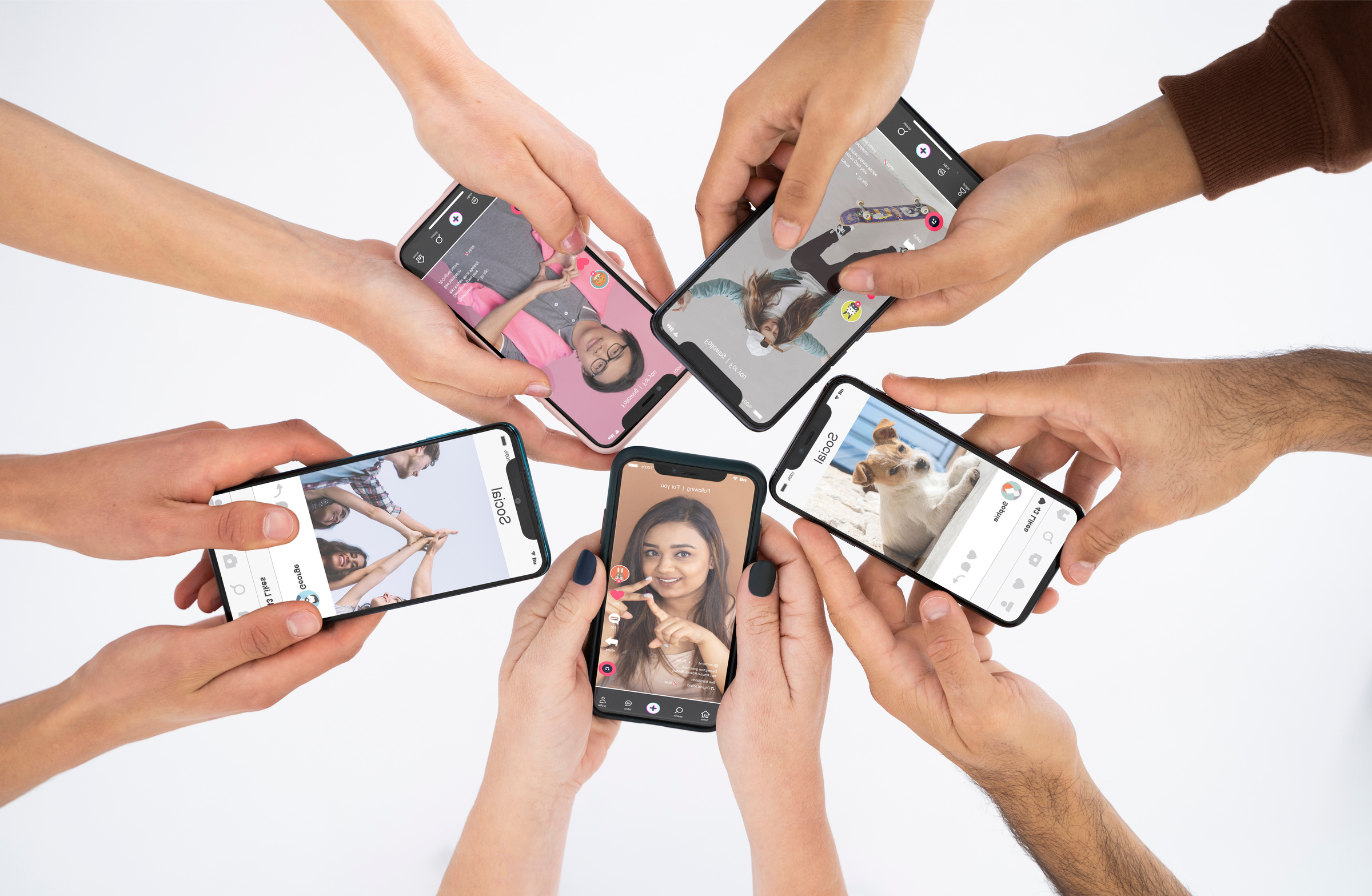Views vs Engagement: When to Focus on Each Metric?
Delve into the dynamics of views vs engagement. Learn what metric matters more for different business objectives and learn how to boost each.


Views measure reach and tell you how far your message has traveled.
Engagement, on the other hand, signals whether that message sparked interest, trust, or even intent.
Neither equals ROI, but both can serve as leading indicators when tied to the right campaign goals.
In this post, I’m breaking down views vs engagement: when each matters, how video length, format, and platform behavior shift the numbers, and how to focus on social media metrics that actually drive results.
Key takeaways
-
Views and engagement benchmarks: Benchmarks reveal that small accounts see higher engagement rates, while big accounts win on total views.
-
Examples of campaigns optimized for views: Spotify Wrapped, Dove’s Reverse Selfie, and Gap x KATSEYE show how views drive massive reach and awareness.
-
Examples of campaigns optimized for engagement: Adobe’s #AdobePerspective and HubSpot’s #GrowBetter prove that spotlighting users fuels authentic engagement.
-
When to aim for one vs the other: Leverage views campaigns when you want to to maximize reach and virality, and engagement when you want to build trust, loyalty, and action.
What counts as a view on different social platforms?
On Instagram, views measure the total number of times your content is played or displayed. But Instagram treats different post types differently, and knowing the rules can save you from obsessing over numbers that don’t matter.
- For static image posts and carousels without videos: The moment your post is seen by users in their feed, it's counted as an Instagram view. There is no time threshold or engagement required to qualify it as a view.
- Reels and carousels with videos: A view only counts if someone watches a video for at least three seconds. Even if the video autoplayed silently, those three seconds are enough. Loops don’t inflate your numbers–each user counts only once per video unless they watch another three-second stretch.
- Stories: A view is counted when a user taps on a Story to view it. There’s no time threshold for Stories as well.
Here things are pretty simple:
- A view is counted when someone watches your video for at least three seconds.
TikTok
TikTok is the most generous when it comes to views.
- The moment your video starts playing in someone’s feed, even if they only watch for a second before scrolling, that counts as a view.
- Repeat views also count. So, if someone replays your video five times, TikTok adds five views to your total.
On LinkedIn, a video view counts after someone has watched for at least two seconds. At the moment, you can only upload videos directly to your feed.
Also, LinkedIn is experimenting with vertical, short-form videos, similar to TikTok, Instagram Reels, or YouTube Shorts. This is a clear sign that LinkedIn is pushing video to play a much bigger role in how content gets discovered on the platform.
X (formerly Twitter)
On X (formerly Twitter), a video view is counted when someone watches for more than two seconds. This applies to both live broadcasts and uploaded videos in the feed.
But, and this is a big but: only logged-in users count. That means:
- Logged-out users? Not counted.
- Embedded videos on other sites? Not counted.
Your numbers might look slimmer than expected, but at least you know who’s actually there.
YouTube
YouTube sets a higher bar: a video view only counts if someone watches for 30 seconds or more.
For Shorts, though, every play or replay counts as a view, even if it's only for one second. To balance that, YouTube introduced a separate metric called ‘engaged views,’ which tracks how many people actually stuck around for a certain number of seconds.
Views and engagement benchmarks for different social media platforms
Engagement
As seen in our Instagram benchmarks report, Instagram Reels are the second most engaging content format on the platform, being surpassed by carousels. And as you might have expected, when analyzing different page sizes, the engagement starts to drop as the number of followers increases.
Here’s the Instagram Reels engagement rate breakdown.
In fact, there’s over a 50% drop in engagement when you compare small accounts with less than 5k followers to large accounts with more than 100K followers.
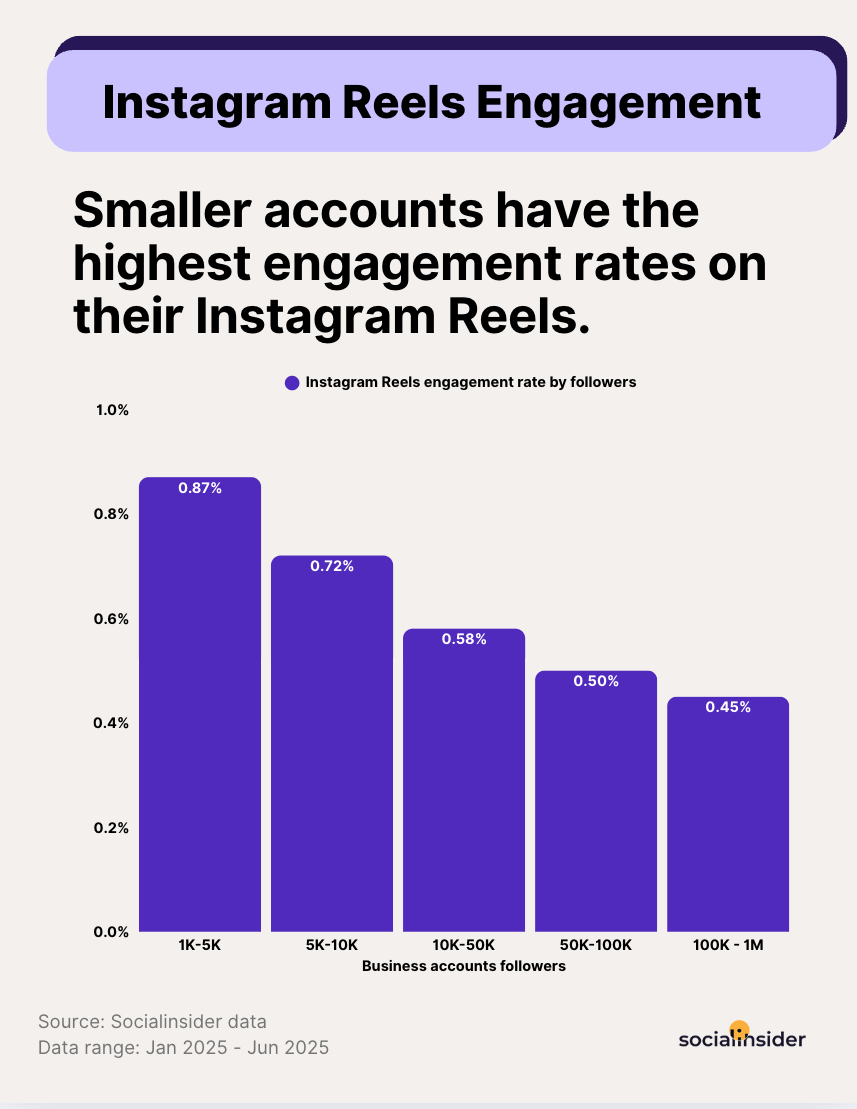
Also, longer Reels between 60 and 90 seconds get the highest engagement rate, which could be because they get more users to stick around and engage.
Views
Even if larger accounts don’t get as much engagement, they do get double the views as the smaller accounts. The view counts really accelerate for accounts with over 50k followers. That means, even if the engagement rate looks small as a percentage, the actual number is a lot higher.
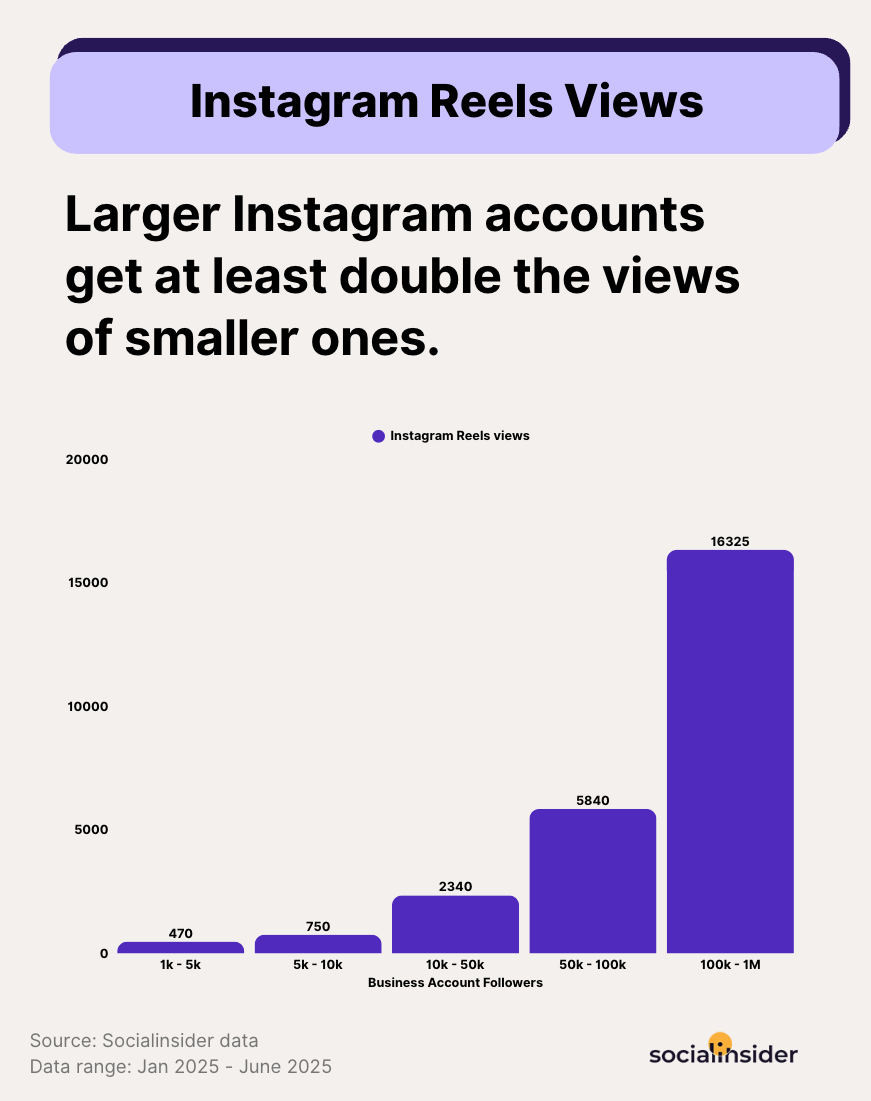
Longer Instagram Reels also get more views. But there’s a clear drop-off around 90 seconds, after which the views start to decrease. That clearly indicates that while most Instagram users are interested in watching longer Reels, their attention span has limits.
In practice, this means you can experiment with longer content if the topic demands it, but you should still aim to deliver your key message or hook within the first 60-90 seconds.
Engagement
Facebook Reels engagement for business profiles follows a similar trend as Instagram Reels–higher for small accounts and lower for big accounts. But compared to Instagram, the average engagement rate is much lower.
Just like on Instagram, longer Facebook Reels tend to perform better, with videos in the 90-120 second range performing the best. That means, like Instagram, Facebook users are willing to invest a bit more time in content, but only up to a point.
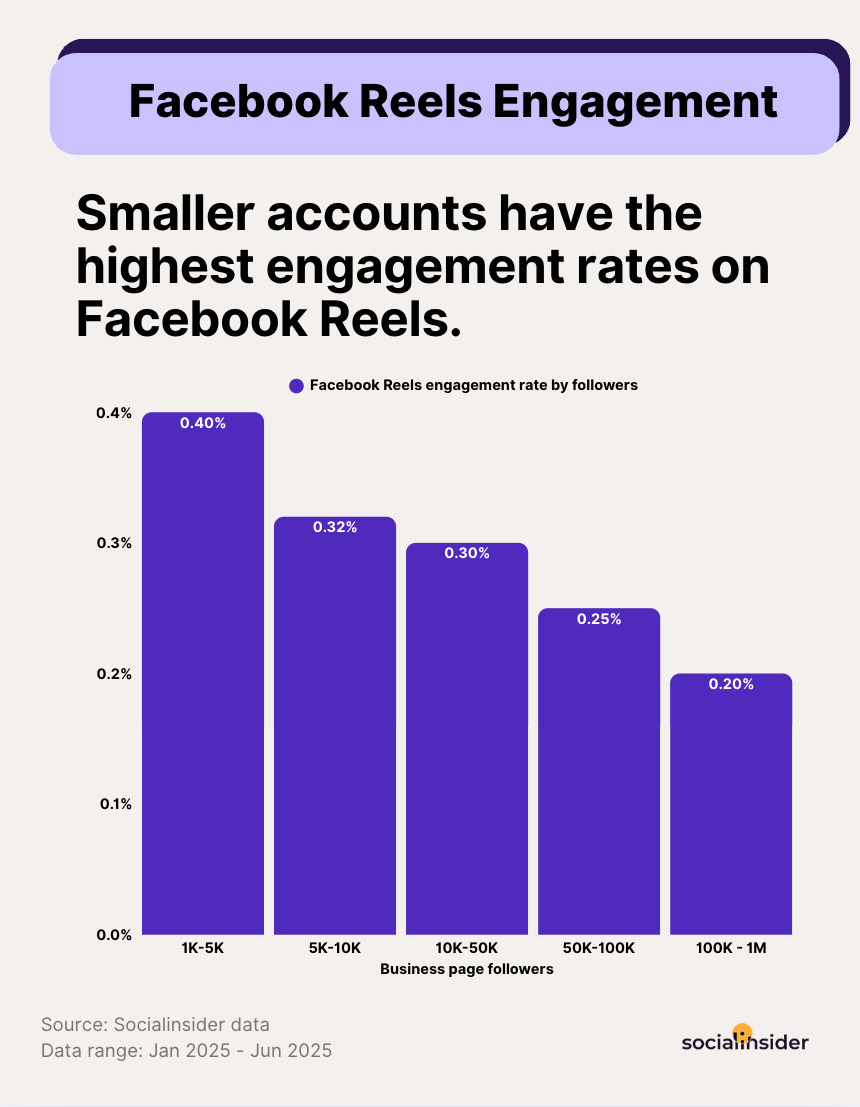
Views
Our benchmark data shows that view accounts increase sharply as the number of followers increases. In fact, views more than triple between 5K and 50K followers and nearly triple again between 50K and 100 K. That means large accounts still have huge potential on Facebook.
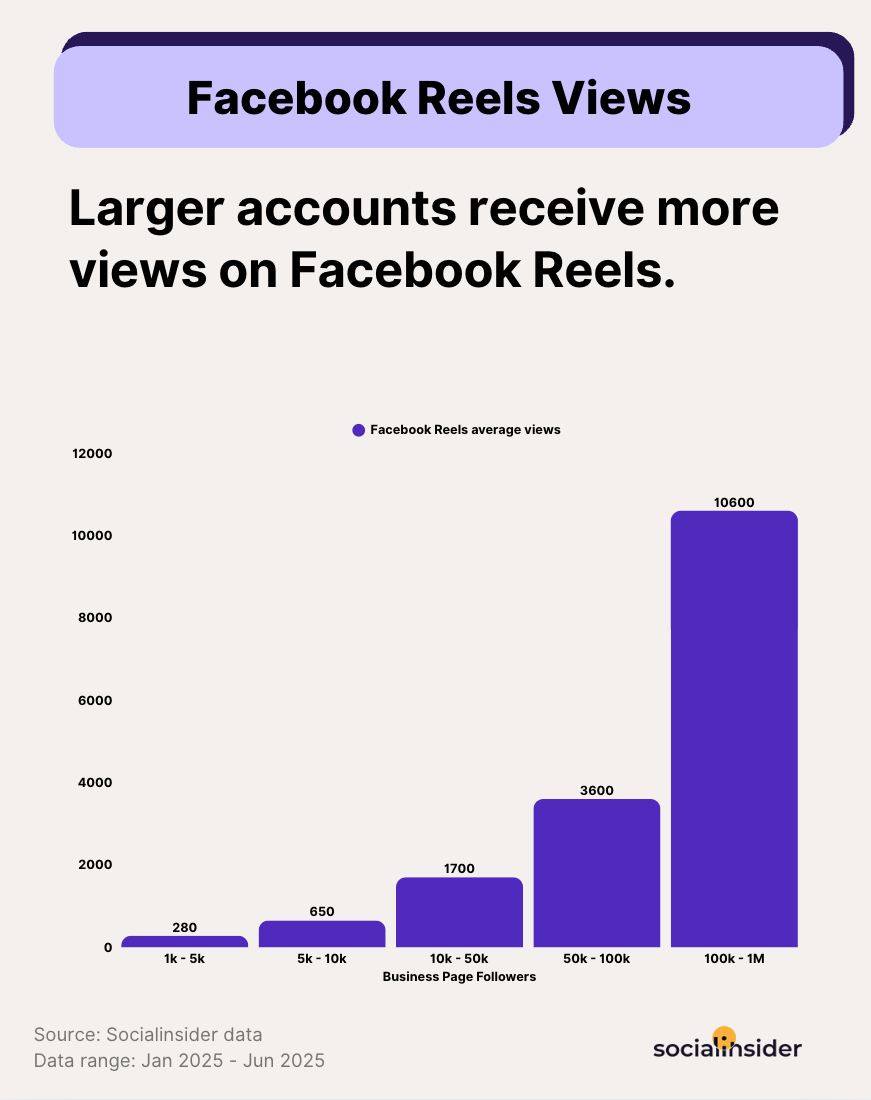
TikTok
Engagement
TikTok’s engagement rates are much higher than other social media platforms. Unlike most, it measures engagement per view, which is a far more honest way to see if your content is actually landing with people.
The engagement rate is definitely higher for smaller accounts, but it doesn’t drop off drastically for larger accounts either.
While TikTok’s popular short videos (15 seconds or less) still show considerably high engagement, there is a clear shift in user behavior on the platform.
The engagement rate on TikTok increases as the video length grows, and the highest engagement rate is seen beyond the two-minute mark. This shows that users aren’t just interested in short dances anymore–they’re sticking around for longer content that tells a full story.
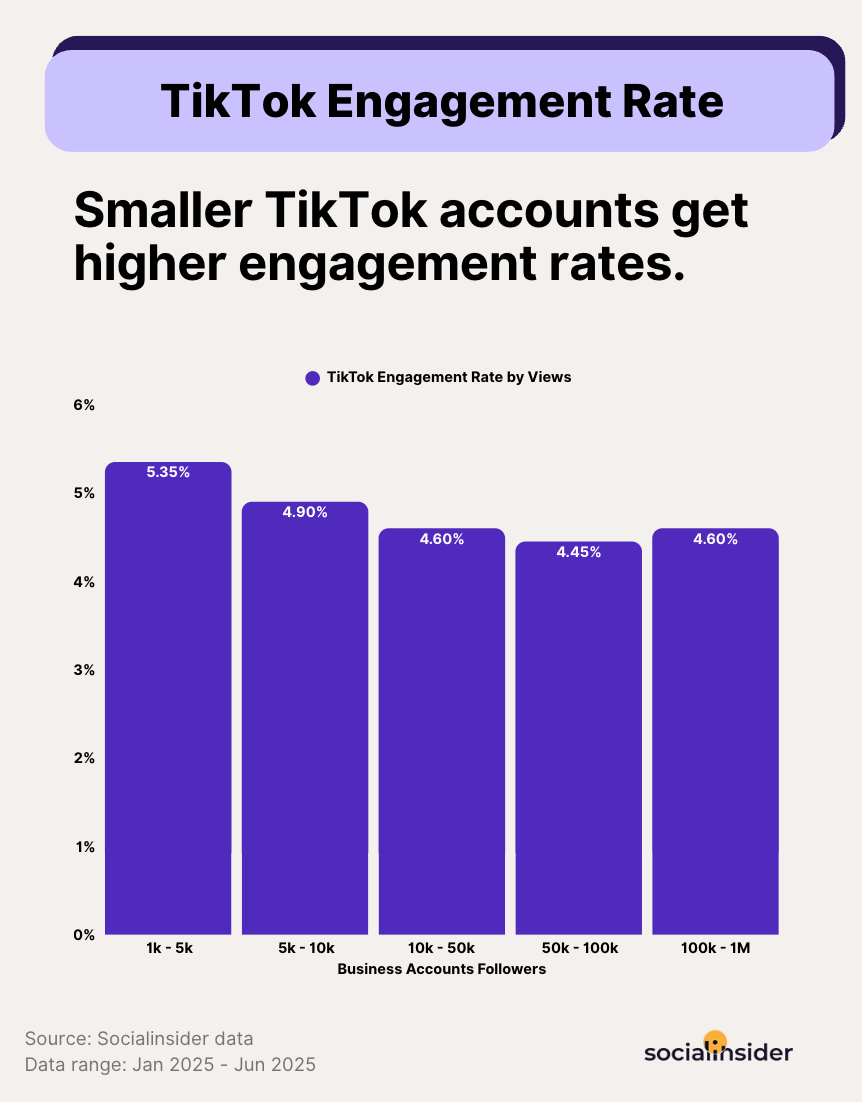
Views
Our data shows that views increase sharply as follower count grows. From 10K to 100K, average views jump from about 4.4K to 10.8K. Once you cross 100K, they again increase by 3X and reach 31K. It is pretty clear that TikTok trusts content from accounts that perform consistently well.
Longer videos also perform better than shorter ones in terms of views. Videos over 60 seconds get more than double the views of shorter clips, and the trend continues past two minutes.
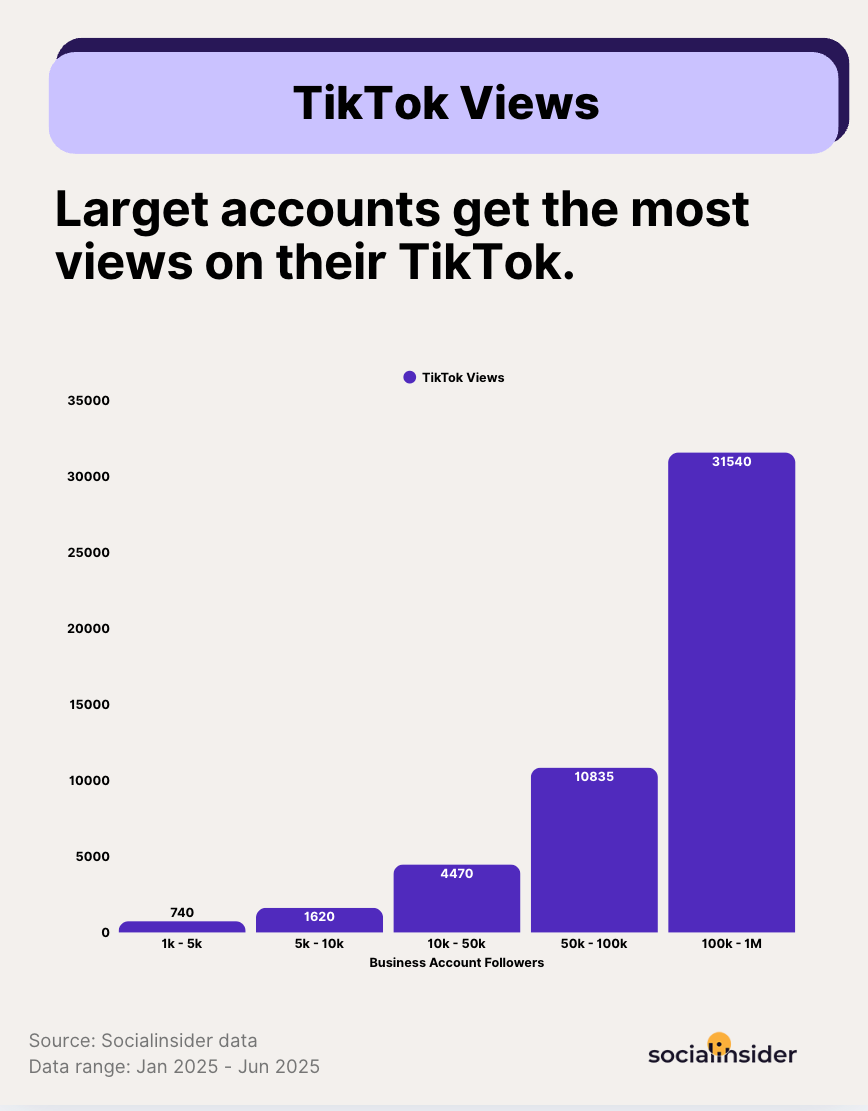
Video is not the primary, but it's growing at a fast pace. Most importantly, engagement rate on LinkedIn is pretty stable across all accounts–small and big. That means, if your brand is still not leveraging videos for LinkedIn, you’re already losing out on a lot of untapped potential.
Also, when looking at the performance of different video lengths, engagement on LinkedIn peaks for videos around 90-120 seconds, reaching over 7.2%. Even videos over three minutes hold strong, with engagement around 6.3%.
Take it from me, LinkedIn audiences are primed for content that teaches and informs, and they’re willing to stick around for videos that keep them interested.
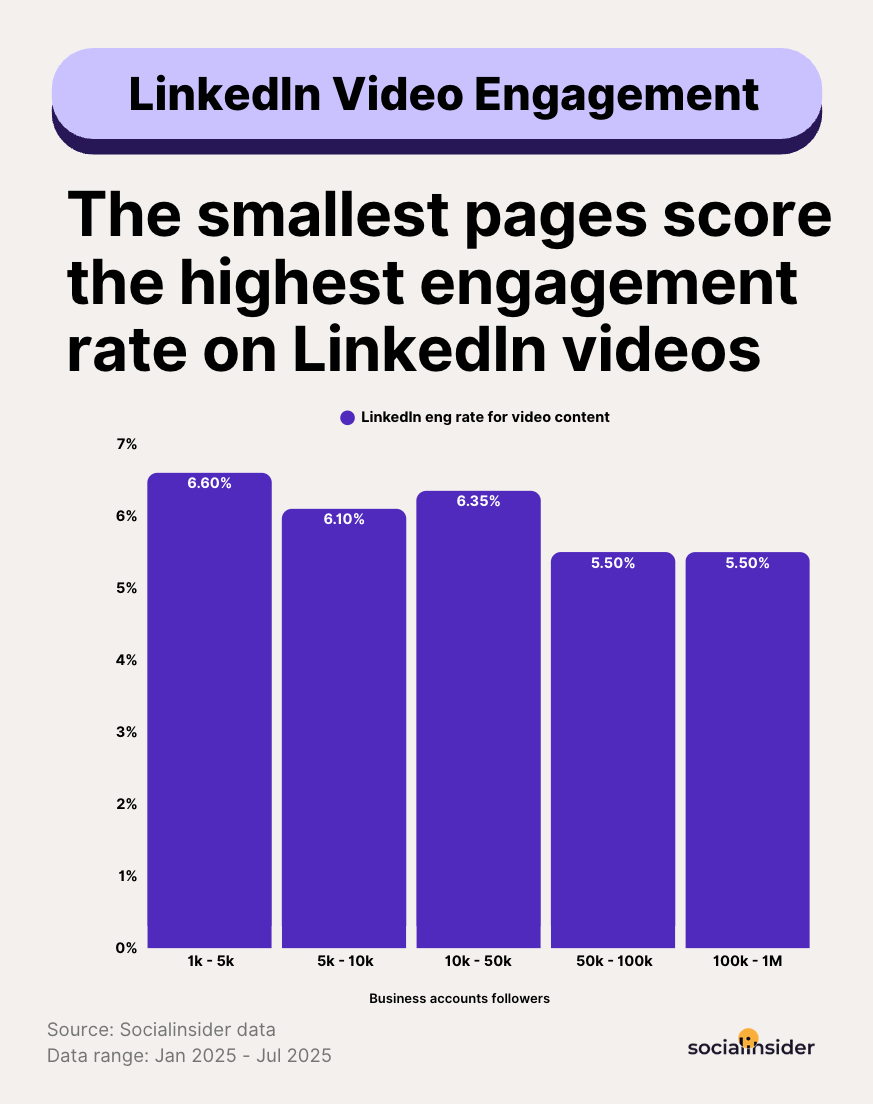
Views
Views on LinkedIn increase steadily as accounts grow from under 5K to 5k-10K and then to 10k-50K followers. After that, growth slows down, creating a plateau between 50K and 100K followers. Once an account crosses 100K, views jump sharply again, clearly indicating that LinkedIn rewards both audience size and consistently valuable content.
LinkedIn doesn’t exactly play by predictable rules when it comes to video length. Though once videos stretch beyond 3 minutes, they pull in the highest average views. If this isn't a sign that LinkedIn wants binge-worthy videos, I don't know what is.
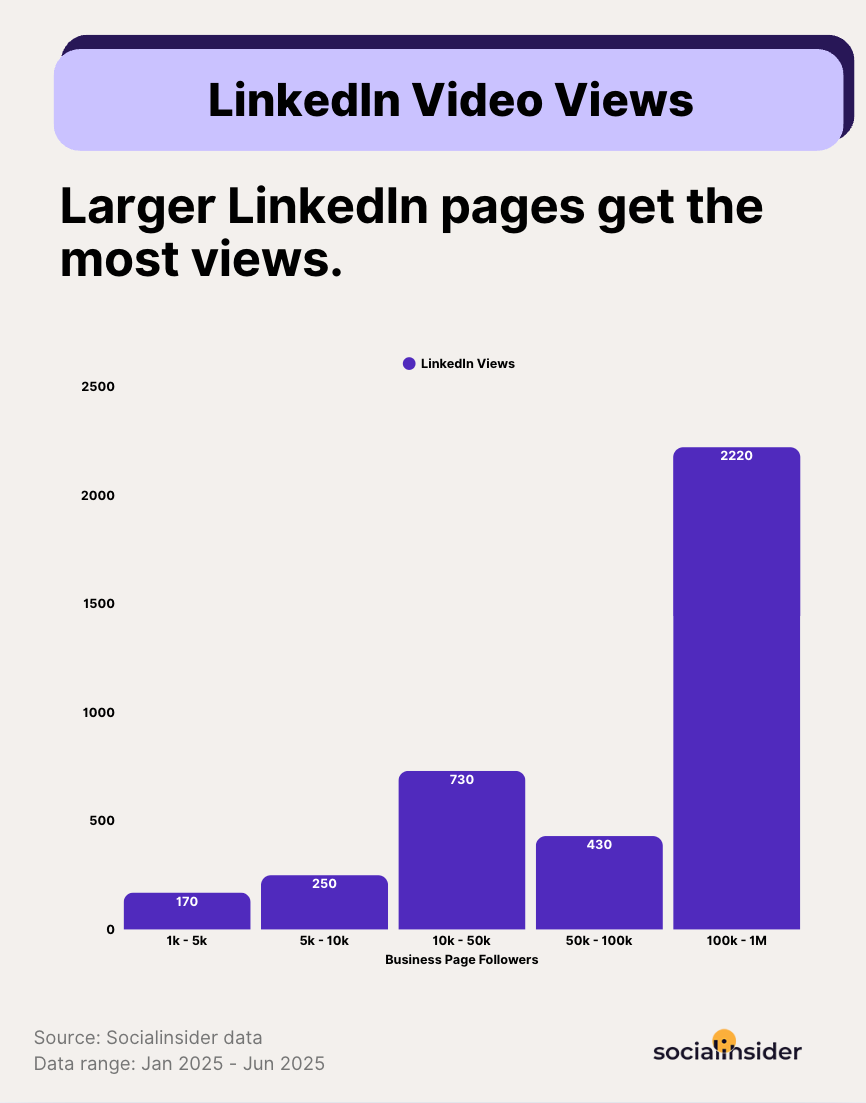
Examples for campaigns centered on views:
Spotify – Wrapped Campaign (annual, Instagram/TikTok/Twitter)
What they did:
Every December, Spotify gives users a personalized highlight reel of their listening habits, which includes their top artists, top songs, and total listening minutes. Wrapped, my favorite end-of-the-year campaign, turns each user’s data into a visually engaging vertical video, encouraging shares through Instagram Stories, TikTok, and even Twitter.
Results:
- Billions of views across platforms every year.
- Daily active users spiked thanks to FOMO-driven sharing.
Why I love it, and I think it worked
- User-generated content drives reach: People share their Wrapped stories organically, amplifying Spotify’s message across platforms.
- Designed for vertical video and easy sharing: Wrapped’s vertical format, bold graphics, and personalized stats make people want to share it on their own profiles
- Gamification and competition: Features like Top Fans and listening comparisons spark friendly rivalry, encouraging more shares and engagement.
- Influencer boost: Artists and podcasters publicly share their Wrapped stats, organically reaching hundreds of millions more users.
Dove – Reverse Selfie (TikTok/YouTube/Instagram)
What they did:
For me, Dove is one of those brands that just nails it every time. Let's talk a bit about Reverse Selfie, which consisted of a video campaign revealing how selfies are often heavily edited, in an attempt to raise awareness about how social media influences reality perceptions.
The launch itself was cleverly orchestrated. Dove first released the short film, a powerful visual that showed a young girl gradually “reversing” her selfie edits until she was back to her natural self. The storytelling was simple, emotional, and direct—exactly what makes Dove’s campaigns resonate so well.
From there, the brand extended the conversation across digital platforms, pairing the video with statistics and expert insights on the negative impact of retouching apps on self-esteem, especially among young girls. The messaging was framed as both an eye-opener and a call to action: not just look what’s happening, but let’s change this together.
That framing—supportive, human, and solutions-oriented—is what helped Reverse Selfie go beyond just another viral video to a conversation-starter that aligned seamlessly with Dove’s long-term “Self-Esteem Project.”
Results:
- Millions of views on YouTube and Instagram
- Campaign achieved 6 billion global impressions, which was the highest ever for a Dove purpose campaign
- Increased brand affinity by 21% and cross-category sales by 11.9%
- Hashtags #NoDigitalDistortion and #TheSelfieTalk sparked wide social engagement and user-generated content.
Why I love it, and I think it worked
- Cultural relevance: The campaign tackled a real issue by addressing teen girls’ self-esteem in the age of heavily edited selfies.
- Highly shareable content: The reverse video format, split-face graphics, and emotional storytelling encouraged viewers to share the content widely across social platforms.
- Influencer amplification: Celebrities like Lizzo helped extend the campaign’s reach, generating millions of additional views organically.
- Purpose-driven storytelling: The authentic messaging reinforced Dove’s long-standing “Real Beauty” positioning, driving views
Gap x Katseye — “Better in Denim”
What they did:
This campaign recently made waves in the social media world and I absolutely loved it. What was it all about? Gap dropped a video starring global girl group KATSEYE, clad in Gap denim, dancing to a reimagined version of Kelis’s 2003 hit “Milkshake. That choice alone was genius — a song loaded with early-2000s nostalgia that also feels perfect for TikTok-era remixes.
This campaign is basically a masterclass in modern pop-culture marketing.
Results:
- Record-breaking reach: The campaign became the most shared TikTok in Gap’s history. It was also on the number one TikTok search during launch week.
- Massive reach: The video racked up over 576 million views across Gap’s channels and broke Instagram’s 24-hour view record for the brand, with around 15 million views in a single day.
Why I love it, and I think it worked
- Cultural Relevance. Nostalgia meets Gen Z — the 2000s are back, and Gap leaned in hard.
- Influencer Amplification. KATSEYE brought not only their music but their global fanbase, giving Gap instant credibility with a younger audience.
- Brand Alignment. Denim has always been Gap’s DNA. Instead of chasing trends blindly, they reframed their core product in a way that felt fresh, bold, and viral.
@gap All together now. @katseyeworld gives one more taste of their performance. Explore the campaign at link in bio. #BetterinDenim ♬ original sound - Gap
Example of campaigns centered on engagement
Adobe – #AdobePerspective
What they did:
Adobe launched the #AdobePerspective campaign, encouraging creators to share original artwork made with Adobe software. The most eye-catching pieces were elevated on Adobe’s official channels through the Art Makers Series, giving independent designers global visibility.
Results:
- Creators supported each other in comments with validation and encouragement, sparking conversations.
- Shares and reposts amplified the reach across design communities worldwide.
- Adobe gained organic exposure while strengthening its role as a brand that celebrates and uplifts creators.
Why I love it, and I think it worked
- The campaign turned community engagement into brand advocacy, naturally
- By celebrating artists instead of just products, Adobe positioned itself as the creative ally
- Visibility and validation built long-term goodwill, not just short-term buzz
HubSpot – #GrowBetter
What they did:
With #GrowBetter, HubSpot invited businesses to showcase how they were thriving with the platform by sharing their own stories on LinkedIn and Twitter. The most compelling posts didn’t just get a like — HubSpot pulled them into content hubs, case studies, and even polished video features, amplifying customer voices across its channels.
Results:
- A steady flow of authentic user-generated content, rare in the B2B space
- Customers transformed into vocal advocates as their stories were spotlighted
- Increased cross-business engagement, with companies learning from and interacting with one another
- Organic reach amplified as participants proudly shared HubSpot’s recognition with their own networks
Why I love it, and I think it worked
- Real customers became the heroes, not just the product
- The campaign created a self-sustaining loop of engagement and amplification
- By elevating its users, HubSpot built trust and authenticity while earning organic reach
- It reframed “growth” as a community effort, not a sales pitch
When should views be the primary metric?
Views are all about reach. They tell you how many users saw your content, so they matter most when the goal is visibility, not conversation.
Here are the campaigns where views should be the primary metric:
- Brand awareness campaigns: If you’re trying to introduce your brand or product to a big audience, views show how far you’ve spread.
- Breaking news or trending topics: Speed and reach matter more than comments when you are trying to target a growing trend or news. Views tell you how fast your message is traveling.
- Creator & fandom collaboration: Brands pay influencers for exposure. Sales and conversions come in much later. High view counts prove that your sponsored content was actually seen.
- Stunt and surprise content: These campaigns are built to shock, delight, or interrupt the feed of your users. They are focused on virality and the number of views matter a lot more than comments or likes.
- Risky or bold messaging: American Eagle’s attempt at edgy, unconventional messaging is a cautionary tale. Yes, it got attention, but it also attracted heavy criticism for missing the cultural mark. Bold campaigns spread fast and views are the primary way to measure the impact (good or bad).
- Satire and parody as differentiation: Liquid Death thrives on parody and absurd humor. The brand’s goal is not to spark debate in its comment section, but to get increased reach and cultural recognition.
- Purpose-led or social themes: Dove’s anti-beauty campaign shows how purpose-driven storytelling gets emotional reactions and shares. But the real measure of success is how many people it reaches.
When should engagement be the primary metric?
Engagement is about action. It tells you if people actually took an action after seeing your content instead of just scrolling past it.
Here are the campaigns where engagement should be your main metric:
- Building community and brand loyalty: Comments, shares, and conversations show that your content resonates with your audience.
- Conversion-focused campaigns: Engagement is often the first step toward clicks, sign-ups, or sales. So, more engagement means more chances of conversions.
- User-generated content campaigns: You want to see who’s actively participating and amplifying your message to identify brand advocates.
- Insight-led debate and discussion content: Polls, quizzes, and provocative data-driven posts spark conversation. Engagement here shows that your audience is reacting, and actively debating your ideas.
- Purpose-driven missions campaigns: Campaigns tied to social issues or brand missions thrive on participation. Shares, comments, and mission pledges measure whether your audience is connecting with your cause or not.
How to translate social data for the C-Suite?
For social media leaders, it’s essential to communicate the business implications of both reach (views) and engagement to executive stakeholders. While tactical metrics matter to channel owners, the C-suite wants to know how social performance drives top-line business results.
To elevate your reporting:
- Connect metrics to impact: Show how an increase in views expands market exposure, while a spike in engagement relates to higher conversion rates or increased customer advocacy.
- Emphasize predictive value: Use rising engagement trends as early signals of customer interest or potential demand, informing product launches or sales strategies.
- Attribute influence across channels: Link social metrics to wider marketing and sales outcomes—such as increased website traffic, newsletter sign-ups, or in-store visits—to underline social’s full-funnel impact.
- Spotlight community and loyalty building: Frame rising engagement as an indicator of deeper brand loyalty and customer retention, which contribute to long-term business growth.
Final thoughts
Views and engagement aren’t in competition — they’re complementary. Views measure how far your message traveled; engagement shows whether it truly landed. The real trick is knowing when to prioritize one over the other, and how to tie both back to your campaign goals.
At the end of the day, the most effective social media strategies don’t choose between the two — they use views to start conversations and engagement to sustain them, turning attention into action and reach into results.
Analyze your competitors in seconds
Track & analyze your competitors and get top social media metrics and more!
You might also like
Improve your social media strategy with Socialinsider!
Use in-depth data to measure your social accounts’ performance, analyze competitors, and gain insights to improve your strategy.


